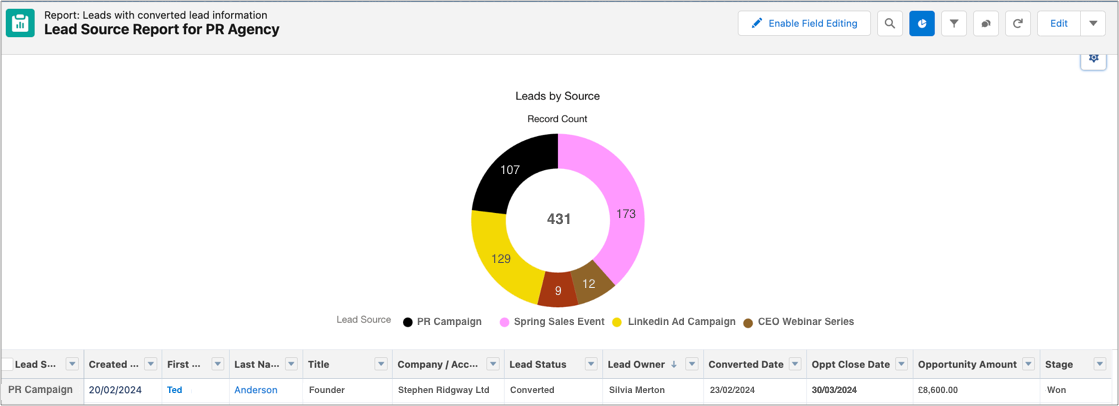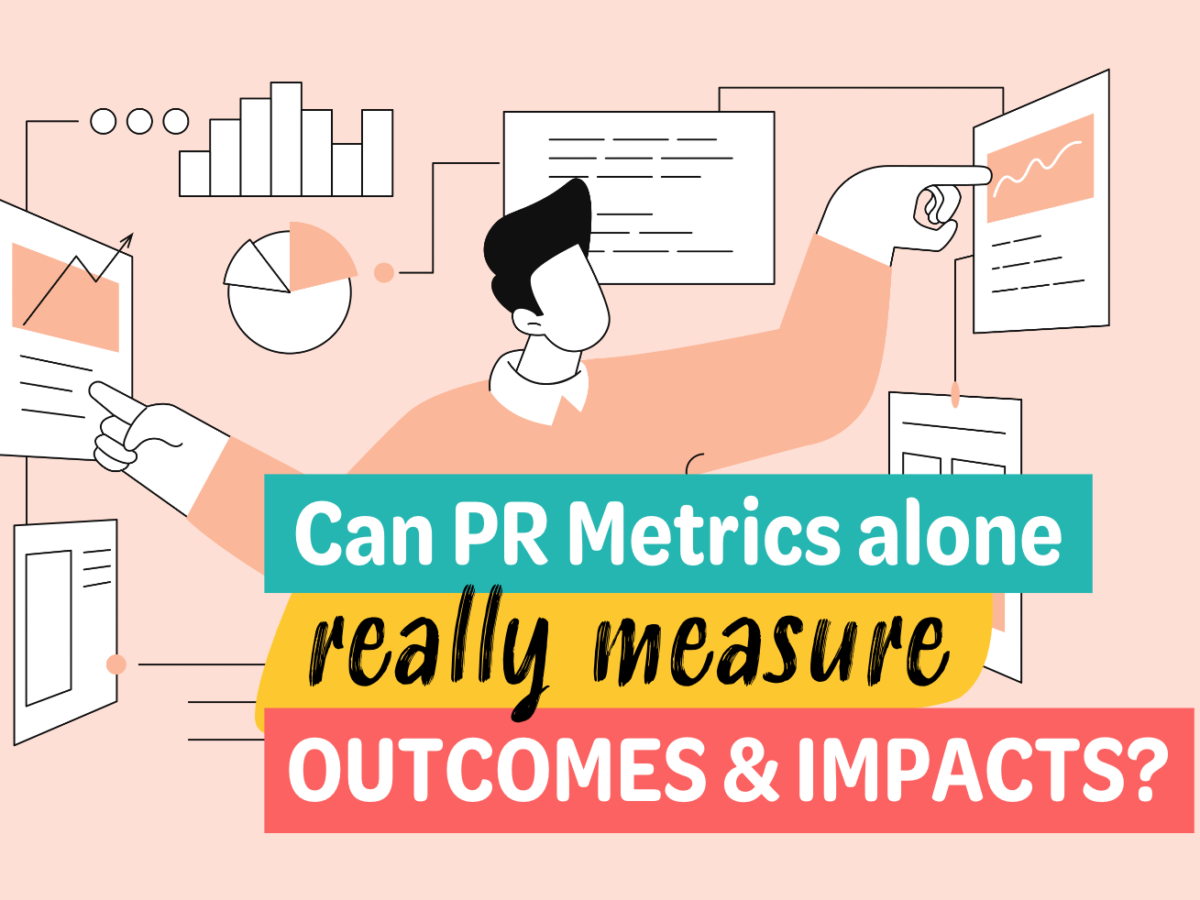
One of the most fiercely debated topics in PR surrounds the industry’s ability to prove its worth.
That’s certainly been the case over the 15 years that I’ve been in the business, was no doubt the case 50 years before that, and will surely be the case in 50 years from now when AI-powered PR drones are pitching the only remaining journalist about a survey that shows dogs prefer to eat from square bowls.
As things stand today, can the most popular PR metrics actually, genuinely, properly show without doubt that a campaign has helped an organisation achieve its objectives?
According to AMEC’s Integrated Evaluation Framework, these objectives can be summarised as outcomes and impacts.
Outcomes:
“Measure the effect of the communications on the target audience. Have the target audience increased understanding, has it changed their attitude to the topic, has it increased trust and/or preference, has it had an impact on the intention to do something (e.g. trial, subscribe, register) or increased online advocacy.”
Interestingly, this definition does not require our target audience to actually do something, just to think about something differently, or intend to take an action. In other words, to measure outcomes we really need to delve into the minds of our audience.
Impacts:
“Cover(s) reputation improvement, relationships improved or established, increase in sales or donations, change in policy, or improved social change. This is a clear demonstration of business outcome and link to organizational objectives.”
Partnerships created, revenues generated, policies enacted. Impacts are the holy grail of PR, and they’re just as hard to claim.
Outcomes and impacts: can PR metrics provide concrete evidence?
Now, let’s explore the range of PR metrics available to practitioners today, and ask ourselves if they can really be used to measure outcomes and impacts.
Number of Pieces of Coverage
The oldest PR metric in the book. It’s not controversial to say that 0 pieces of coverage = 0% chance of success. However, it’s also not possible to state with confidence that a bucket load of coverage has moved the needle. We’ve all seen it: a campaign delivers 300 articles, everyone’s delighted – except the ultimate budget holder who’s looking at sales figures and sees no movement. So this metric alone simply can’t do the job.
Reach
This PR staple is based on total monthly website sessions, or unique website visitors. The aim is to gauge the potential audience for a given article, but the reality is that it is simply an estimate for the total readership of a publication.
One well known problem is that Reach figures can be ludicrously high. It only takes a few hits on sites like Yahoo News or MSN to deliver numbers in the billions – often higher than the population of planet Earth. And we also know that not everyone who reads a publication reads the article. Far from it. Finally, and most importantly, there’s no way of directly linking the Reach of a campaign with any potential outcomes or impacts.
Coverage Views
Understanding how many times a piece of coverage has been seen is super valuable for PR professionals, because it provides a more realistic and credible number to share with clients or executives. It’s often much lower than Reach and that’s actually a good thing for the reasons outlined above.
When the Coverage Views metric became accessible for the industry it caused waves, and continues to do so as the data gets more sophisticated (Releasd measures views not only on the website, but across open and dark social too for example). However, this is simply a more granular version of Reach, so the same limitations apply.
Domain Authority
Domain Authority provides an indication of the standing of any given website within its category. Scored out of 100 on a logarithmic scale, it actually gets harder for a website to obtain a higher figure. DA can be helpful in some cases; for big consumer campaigns it’s good to see a high average DA as that implies that coverage has been achieved across lots of high profile publications. But for most campaigns, where smaller, niche brands are being promoted, DA is likely to be lower…which is fine. As such, DA alone cannot be linked to outcomes or impacts.
Share of Voice
Share of Voice is another useful PR metric. It’s a luxury for most of the market because one has to know how much coverage competitors are getting too, and that can be expensive. A higher share of voice is generally better (unless the brand is in a crisis situation) but this metric is measuring the media landscape, rather than the mental landscape of the audience. Therefore, SOV can’t provide direct evidence that a campaign has driven outcomes – and certainly not the ultimate goal of impacts.
Sentiment
PRs decide how a story is packaged up, and with whom it is shared. However, they cannot control how it will be communicated to the public. That’s where sentiment analysis comes in. Sentiment has been a staple of PR for decades, but (as with Share of Voice) it relates to the sentiment of the coverage, not its readership. Therefore, to be strict, even if a campaign has demonstrably 100% positive sentiment, this does not represent incontrovertible evidence that it’s had any effect on the consumers of that coverage.
Key Message Penetration
Key Message analysis can provide hugely valuable insights into how well a PR campaign was executed. Coverage that’s laden with a brand’s talking points has a good chance of driving outcomes or impacts if it’s placed in the right publications. However, similar to Sentiment and SOV, key message analysis alone can only measure the media’s output – there’s no guarantee that the audience have actually absolved or acted on those key messages.
We’ve now covered most of the pure PR metrics that are used to measure campaign performance. In their present state, they are simply not sufficient to prove beyond doubt that the work done has led to genuine outcomes or impacts. That’s not to say that it hasn’t – just that they do not provide enough evidence.
Can PR metrics come close to proving outcomes and impacts?
The good news is that, when combined to form a coherent narrative, PR metrics can put a really strong, convincing case forward. Let’s take an example:
A PR campaign is launched to raise awareness of a new product. It’s a unique, innovative square dog food bowl that is way ahead of its time. The PR team responsible use a variety of metrics to evaluate the performance of the campaign:
Reach: they find that the campaign had a high total reach vs previous benchmarks
Coverage Views: the Coverage Views number is also impressive, beating expectations
Domain Authority: many mainstream publications featured the story, so the average DA was higher than usual
Share of Voice: this increased significantly during the period in question vs out-of-touch competitors who are still peddling round dog bowls
Sentiment: 95% of the coverage had a strongly positive sentiment: the media loved the product
Key Message Penetration: every piece of coverage featured at least two key messages; the bowl was uniquely square, and dogs really preferred that shape
Now, let’s imagine the brand in question had no way of tracking the source of orders; they sell through retailers, there’s no form on their website, website analytics are not set up, there is no sales team etc. Despite this, by combining the PR metrics above, I think it would be credible for the PR team to claim credit for any boost in sales during and indeed some time after that period.
The challenge is that these situations are quite rare: often other marketing campaigns are running concurrently, or the PR metrics simply do not put a strong enough case forward.
What then?
Marrying PR and non-PR metrics to truly measure outcomes or impacts
The key here lies in marrying PR metrics with measurement techniques that sit outside of PR. To achieve this, access to the relevant people and data is essential.
Claire James is Client Services Director at Skout, a B2B PR and Marketing agency. She says:

“At Skout, we see measurement as more of a continual feedback loop – you are looking at what works and what doesn’t when it comes to delivering real attributable results from a PR programme. It can be a process of trial and error but if you have a client who is willing to work with you to understand and overlay the data points, what you have is a powerful demonstration of how PR has a positive impact on the bottom line.”
Let’s explore how this could work in practice.
i) Analysing social media engagement
Here is the definition of outcomes again: “Have the target audience increased understanding, has it changed their attitude to the topic, has it increased trust and/or preference, has it had an impact on the intention to do something”.
Thanks to the APIs provided by social platforms, it’s now possible to get engagement data for any given article. Shares, Likes, Comments and more can be tracked by tools like Releasd. This is interesting because we’re finally talking about the minds of the audience. If an article is being engaged with extensively, it tells us that there has been a reaction to the story. Thus, analysis of the content of that engagement, beyond the top line metrics, can provide evidence that PR has shifted attitudes – which is an ‘outcome’.
ii) Using Google Analytics to track Conversions from PR-led activity
Within Google Analytics, ‘Conversions’ can be set up to measure specific website events, like subscribing to a newsletter or buying a product. These are impacts. PR metrics can tell us that coverage appeared on a specific date in a specific publication. Google Analytics can be used to measure Conversions from that publication on that date (or soon after).

[An example Google Analytics report showing Conversions by source]
Furthermore, if Conversions have a value, the ROI from PR can also be calculated:
ROI = Total value of Conversions delivered by PR / amount spent on PR
We’ll be writing a full guide on how to set up Google Analytics to track PR traffic soon.
iii) Using a CRM like Salesforce to track Leads generated from PR campaigns
If an organisation has a sales team and the desired outcome is new leads or sales, then the CRM (Customer relationship management) platform can provide a wealth of information.
For example, a report can be generated that shows leads delivered or sales achieved by source (tracked manually by the sales team). Again, if the value of leads is known, ROI from PR can be calculated. The best case scenario here is that the PR team has its own login and can gather data in real time. Failing that, reports can be exported by existing users.

[An example Salesforce report showing leads by source]
Here’s our step-by-step guide to setting up Salesforce to generate reports on Leads generated from PR.
In conclusion: PR metrics vs outcomes and impacts
Using individual PR metrics to prove that a campaign has driven outcomes and impacts just isn’t possible as things stand. Combining them to put a strong case forward is possible – under the right circumstances – and only relating to outcomes. However, to prove that PR has driven genuine impacts, like sales, one has to combine PR metrics with other, non-PR sources of information.
Just to be clear – this is hard! We rarely hear from PRs who have achieved it, and there’s usually a healthy dose of luck involved. The client was open minded, the budget was there, the tools were available, or the PR campaign was the only thing running at the time.
There’s perceived safety in metrics like Reach or Domain Authority. They imply a return on investment and maybe there isn’t a desire to push much further than that for fear that the truth may reveal something unwelcome.
As Claire at Skout says:
“I think the challenge that a lot of PR agencies and in-house PR teams face when it comes to impact measurement is that it can lay your campaigns open to very intense scrutiny, beyond that of the marketing department. If you are looking at the impacts PR has on a business, it could very well be that the answer to this is nothing measurable. This can be quite worrying for a PR agency trying to protect their relationship with the client and ultimately their fee income.”
But the fact is that good PR works. If we knew what good PR really looked like, then we could double down on that and ditch the rest. That is a win-win.
If the industry is to compete with adjacent functions like social and digital advertising, then it needs to be more honest and open about the limitations and opportunities around measurement.
I believe it all starts at the beginning. Understanding an organisation’s ultimate objectives – beyond “get us coverage” – will naturally lead to an honest conversation about collaborative and affordable evaluation.



